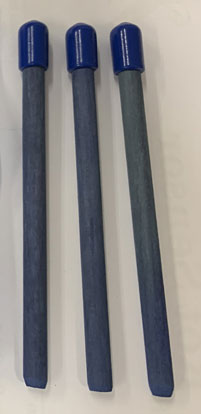How to test damp walls using a so-called damp meter - (don't forget to test for Condensation if you see Mold)
Quick DIY Master Class in Dampness and Condensation - become your own Expert in 1 hour! Buy our "Dampness in Buildings" reprinted book by the great expert Graham Coleman. A great read, short and to the point.
Click here to buy the reprint.
How do Damp Meters Work?
Damp testing meters measure either electrical conductivity between two steel pins touched onto, or pressed into the plaster, masonry or timber, or they use a smooth contact head to measure electrical capacitance. Damp meters usually have two scales, one for timber and one for masonry, but some have only a simple 'reference' scale or a row of coloured lights. Dampness readings in wood usually covers a scale from 0 - 40% maximum (average softwoods are saturated at 28% - 32%) and damp readings in masonry (brick, stone, plaster, concrete) usually range from 0 - 5% maximum.
'Protimeter' is the trade name most familiar to the professional surveyor, but there are many other quality 'damp' meters on the market. Protimeters tend to be expensive, but have a range of special attachments and advanced features required by qualified dampness Surveyors and Chartered Building Surveyors.
Self Help - Diagnosing your damp:
How to test for condensation
Test the walls of the building with our Condensation Test Kit and look for evidence of mold - usually 'black spot' - this indicates that you have Condensation forming on the coldest surfaces in the room. Unless you can increase ventilation and heating, consider using our Anti-Mold Paint Additive or Anti-Mould Emulsion Paint - guaranteed for 5 years!
If necessary, treat all plaster with the anti-mold treatment supplied with the paint and then redecorate.
Measure the Relative Humidity - use our Hygrometer to monitor the conditions in each affected room and use the Memory function to check the exact conditions overnight, the time when temperature falls and condensation is most likely. This meter helps you to control the conditions that cause condensation and to monitor the use of your heating, ventilation and dehumidification.
Available in standard and large display versions
Click to visit the Surveying Equipment Shop
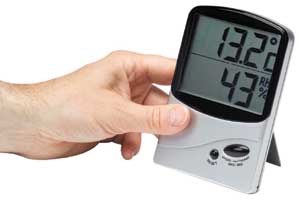
Salts and Mould on a wall suffering from condensation, penetrating and rising dampness
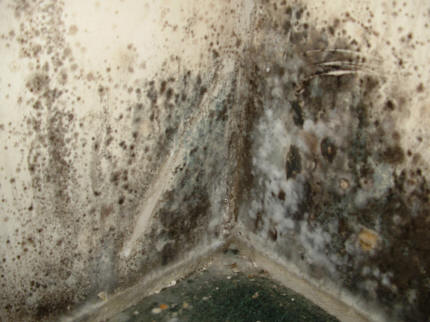
 .
.
How to test damp walls and timber - (don't forget to eliminate the moisture source)
Firstly, check the outside of the building for rainwater penetration - if the walls are absorbing moisture apply a water repellent - UltraProof - check your downpipes and gutters.
Damp testing meter - a sturdy conductivity meter, ideal for testing masonry (brick, stone, plaster) and timber (skirting boards, floors) to give an indication of 'relative' dampness. Always use meters to compare like materials, never to give absolute moisture readings.
Benefits of this meter:
- Pocket sized
- As used by the 'professionals'
- Battery powered
- Direct visual reading
Can also be used to test damp floors and new concrete floors.
(We also sell the Protimeter Range of products, including the Surveymaster. These are Professional instruments, starting at over £100 plus VAT for the basic model.)
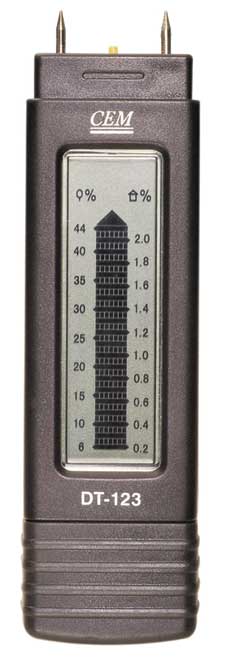
How to test damp walls and timber - general purpose dual scale 'pin' conductivity meter
Click here to see the Data Sheet for the Damp Testing Meter
Click here to see a Quick Guide to understanding the readings from a Damp testing Meter - Front Page
Click here for Quick Guide Back Page
Click to visit the Surveying Equipment Shop
How to detect cold walls and cold spots
Wall temperature gun - the best way to quickly find the cold areas in a building. Compare readings for areas showing no signs of damage and see immediately the extent of the cold - point and click.
Benefits of this thermometer:
- Point and read - no need to be close up
- Lazer pointer shows you the exact spot that you are reading
- Pocket sized
- As used by the 'professionals'
- Battery powered
- Memory for quick reading of multiple spots
Can also be used to test damp floors and concrete floors to locate cold spots, more likely to be the leakage area.
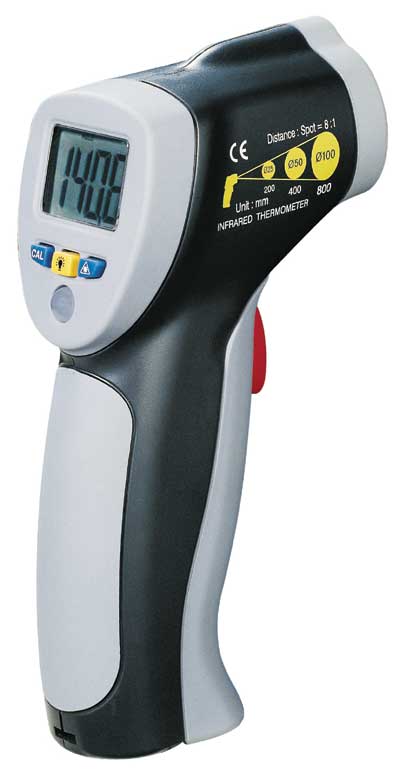
Hand held infra red temperature gun in action
Click to visit the Surveying Equipment Shop
Professional Damp Testing Meters - by Protimeter
Protimeter Mini - The Protimeter Mini can be used for making rapid moisture assessments in a wide range of building materials including wood, masonry, drywall, plaster and concrete. The instrument measuring pins are small and sharp which means measurements can be taken at the surface with virtually no mark left behind.
The numerical values represent the actual percent moisture content of wood (%MC) and the wood moisture equivalent (WME) of other materials. The Protimeter Mini can be used to determine if the fabric of a building is in a dry, borderline or damp condition.
When taking readings in awkward positions, the Protimeter Mini can be used with the moisture probe and lead, supplied as standard with the instrument.
The optional Protimeter Hammer Electrode can also be used with the Protimeter Mini for determining moisture gradients in wood.
Optional Deep Wall Probes can be used with Protimeter Mini to measure the moisture level at depth in a wall, irrespective of the surface condition. Deep Wall Probes are very useful accessories when investigating the cause of the moisture problems within buildings.
Protimeter Mini
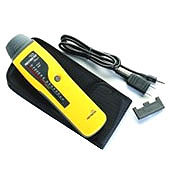
Click here for Wood Calibration Chart
Click to visit the Surveying Equipment Shop
Protimeter Surveymaster - advanced damp tests
Protimeter
Surveymaster -
The Dual Mode Moisture Meter
The current
Surveymaster incorporates two modes of operation - search and measure
(non-invasive and pin type). Search and measure enable the user to distinguish
surface moisture from sub-surface moisture, essential information when
trying to establish the extent and cause of a moisture problem.
Surveymaster is a moisture meter that displays the moisture level values
on a digital display along side a scale of colour coded lights. This digital
moisture meter helps in accurate building material moisture measurement.
This combined presentation of moisture measurement helps the user to map
the extent of problems and monitor changes in condition precisely and
reliably.
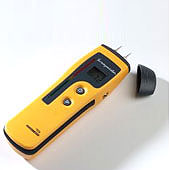
Click here for Protimeter Data Sheet
Click to visit the Surveying Equipment Shop
How to detect Dry Rot
Dry rot detector - the best way to find 'active' dry rot, or to chart the edges of an attack.
Benefits are as follows;
- Change colour to show Dry rot goes from blue to spotty yellow
- Only require an 8mm diameter hole
- Quick fit and remove to view
- Can remain on test indefinitely
Available in boxes of 8, ready to use
Click to visit the Surveying Equipment Shop
Summary
Mould growth is caused by Condensation forming on the surface or inside the building material
Condensation is caused by high levels of moisture in the air condensing on the coldest surfaces in the room, often at night when the temperature falls
Surfaces will be colder if they are damp - rising and penetrating dampness, blocked wall cavities or lack of them, can all increase dampness
Dampness can be caused by common defects, like blocked gutters overflowing, poor pointing, cracked external render.
For immediate help (in office hours) ring our dedicated team of Experts - we will help to diagnose your dampness problem FREE. Ring them on 01626 872886 or use our special CHECKLIST by clicking here.
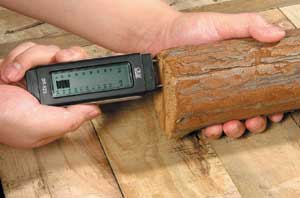
Testing wood for moisture content - at over 18-20% wood can begin to rot
Self Help - Diagnosing your damp:
Click to visit the Surveying Equipment Shop
Membrane | Privacy Policy | Returns Policy | Contact
Property Repair Systems
T: 01626 872886
Use any of our Shopping Pages to place goods in your Shopping Cart - they all use the same Shopping Cart system.

Click to view your Shopping Cart
or continue shopping by clicking on our Membrane Shop link below.
Other Property Repair Systems Sites:
www.epoxy-info.co.uk - epoxy resins for repairing wood, concrete, brick and stone
www.fire-door-paint.co.uk - upgrade doors to 30 minutes fire resistance
www.joist-repair.co.uk - how to quickly repair joists and beams of any size
www.propertyrepairsystems.co.uk - our Home Site
www.steel-fire-paint.co.uk - treat steel with Intumescent Paint to provide fire protection
www.timber.org.uk - systems of repair, with step by step methods
www.timber-repair.co.uk - how to repair timber beams
Site written by: David Moore
David Moore, B.A. (Hons.), C.T.I.S., C.R.D.S. Technical Author
Google+
